Geothermal energy offers notable advantages, including a high capacity factor exceeding 80%, providing reliable baseload power, and achieving up to 99% lower CO2 emissions compared to fossil fuels. Additionally, it presents long-term cost savings, with potential reductions in energy bills by up to 60%. However, we must also consider the disadvantages, such as high initial installation costs ranging from $2.5 to $5 million per megawatt, environmental risks including the release of greenhouse gases like methane, and geographical limitations that restrict accessibility to valuable resources. By examining these factors closely, we can better appreciate geothermal energy‘s potential and its challenges.
Key Takeaways
- Geothermal energy produces 99% less CO2 emissions than fossil fuels, contributing to a cleaner environment and sustainability goals.
- High capacity factor exceeding 80% ensures reliable, continuous energy supply, independent of weather conditions.
- Installation costs can be high, ranging from $2.5 to $7 million per megawatt, potentially deterring investors.
- Environmental risks include the release of trace greenhouse gases like hydrogen sulfide and methane during operation.
- Geothermal resources are often located in tectonic hotspots, which may limit accessibility and require effective management practices.



Overview of Geothermal Energy
Geothermal energy is a powerful and reliable source of energy that harnesses heat from the Earth’s crust. As a renewable energy source, it converts steam generated from heated water into electricity, showcasing its potential to produce between 0.0035 to 2 terawatts of power globally. Importantly, geothermal power plants have a high capacity factor, often exceeding 80%, which means they provide a more stable supply compared to intermittent sources like wind and solar. While the carbon footprint of geothermal energy is considerably lower, with 99% less CO2 emissions per megawatt-hour than fossil fuels, it is crucial to acknowledge that some greenhouse gases and trace heavy metals may still be released during operation. Furthermore, installation costs can be high, typically ranging from $2.5 to $5 million per megawatt.
Advantages of Geothermal Energy

As we explore the advantages of geothermal energy, we should recognize its significant environmental benefits, long-term cost savings, and reliability as an energy source. With a capacity factor exceeding 80%, geothermal power provides consistent electricity generation, while emitting 99% less CO2 per megawatt-hour compared to fossil fuels, which underscores its role in reducing our carbon footprint. Additionally, households utilizing ground source heat pumps can experience energy bill savings of up to 80%, emphasizing not only the economic advantages but also the potential for widespread adoption in a sustainable energy future.
Environmental Benefits
When we explore renewable energy options, one of the standout choices is geothermal energy, which offers remarkable environmental benefits. By utilizing geothermal energy, we can greatly reduce our carbon footprint and support our sustainability goals. Some key advantages include:
- Low Emissions: Geothermal energy produces about 99% less CO2 emissions per megawatt-hour compared to fossil fuels, with average emissions around 122 g/kWh.
- Minimal Land Use: Geothermal systems have a smaller land footprint than other renewable sources, preserving land for natural habitats and agriculture.
- Low Pollution Levels: Geothermal facilities generate low levels of pollution and greenhouse gases, making them an environmentally friendly alternative that aligns with energy diversification efforts.
Incorporating geothermal energy into our energy mix helps us achieve a cleaner, more sustainable future.
Long-Term Cost Savings
Investing in geothermal energy can lead to impressive long-term cost savings for homeowners and businesses alike. Geothermal systems can reduce energy bills by 40-60% compared to conventional systems, translating to substantial financial benefits over time. While installation costs for ground source heat pumps range from £13,000 to £20,000, government incentives can offset up to 30% of these expenses, making the initial investment more manageable. Additionally, with a payback period of just 2 to 10 years, the long-term operational costs become considerably lower, as these systems require 25-50% less electricity for heating and cooling. Ultimately, geothermal systems not only save on utility costs but also offer a sustainable, cost-effective solution for the future.






Reliable Energy Source
One of the standout benefits of geothermal energy is its reliability as a power source. Unlike intermittent sources, geothermal energy offers a consistent energy supply, making it an invaluable asset for our energy needs. Here are three key reasons why geothermal energy is a reliable energy source:
- High Capacity Factor: With a global capacity factor exceeding 80%, geothermal plants provide dependable baseload power.
- Continuous Operation: They can operate 24/7, enhancing grid stability and ensuring a steady energy supply.
- Weather Independence: Unlike solar and wind, geothermal systems aren’t affected by seasonal changes, allowing for year-round energy production.
Additionally, the impressive efficiency ratings of 400-600% for heating applications demonstrate the scalability and adaptability of geothermal energy, reinforcing its position as a leading renewable energy source.
Environmental Impact
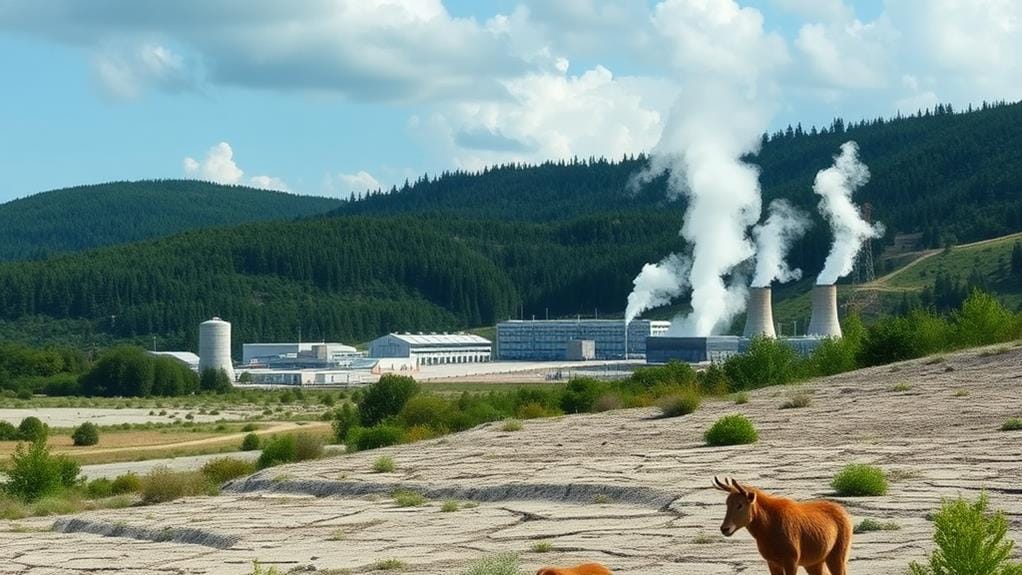
As we consider the environmental impact of geothermal energy, it is crucial to analyze emission levels, land footprint, and potential resource depletion risks associated with its production. While geothermal energy generally emits markedly less carbon dioxide compared to fossil fuels—averaging just 122 g/kWh globally, and as low as 34 g/kWh in Iceland—certain regions have reported emissions that exceed those of coal, illustrating the variability in environmental outcomes based on local practices and geological conditions. In addition, while the land footprint of geothermal facilities is relatively small, the extraction process can still release trace greenhouse gases, such as hydrogen sulfide and methane, which necessitates a careful evaluation of the overall environmental implications.
Emission Levels Comparison
Comparing emission levels is essential for understanding the environmental impact of various energy sources. Geothermal energy stands out as a renewable option with considerably lower emissions compared to fossil fuels. Here’s a brief comparison of emissions:
- Geothermal energy: An average of 122 g/kWh of carbon dioxide (CO2) emissions.
- Iceland’s geothermal plants: Remarkably low at just 34 g/kWh, demonstrating minimal environmental impact.
- Countries like Italy and Turkey: Emissions can soar to approximately 1,300 g/kWh, exceeding coal emissions due to regional variations.
While geothermal energy is not entirely emission-free, with trace amounts of greenhouse gases and sulfur compounds released, it still offers a cleaner alternative in the energy mix, contributing considerably to reduced greenhouse gas emissions.
Land Footprint Considerations
While we’ve examined the emissions associated with geothermal energy, it’s equally important to take into account its land footprint. Geothermal energy systems require considerably less space compared to solar farms, which can occupy hundreds of acres for similar power generation. On average, a geothermal power plant utilizes only 1-8 acres, allowing us to preserve surrounding ecosystems. Additionally, the installation of geothermal facilities typically involves less land disturbance, minimizing the impact on local wildlife habitats and landscapes. Geothermal systems, particularly ground source heat pumps, can be seamlessly integrated into existing residential settings, promoting energy efficiency with minimal surface impact. This reduced land use not only benefits our environment but also supports sustainable development, aligning with our collective commitment to ecological responsibility.
Resource Depletion Risks
Geothermal energy offers a promising renewable solution, but it also comes with significant resource depletion risks that we need to address. If we extract fluids from geothermal reservoirs faster than they can naturally replenish, we face serious sustainability issues. To guarantee we maintain these essential resources, we must focus on sustainable management practices, such as:
- Fluid reinjection into the reservoirs to help restore pressure and temperature.
- Monitoring extraction rates to prevent over-extraction that leads to reduced energy output.
- Researching enhanced geothermal systems (EGS) to explore alternative methods of resource utilization.
Properly managed geothermal projects can mitigate the risks of resource depletion, guaranteeing that we harness this renewable energy source effectively and sustainably for future generations.
Economic Considerations
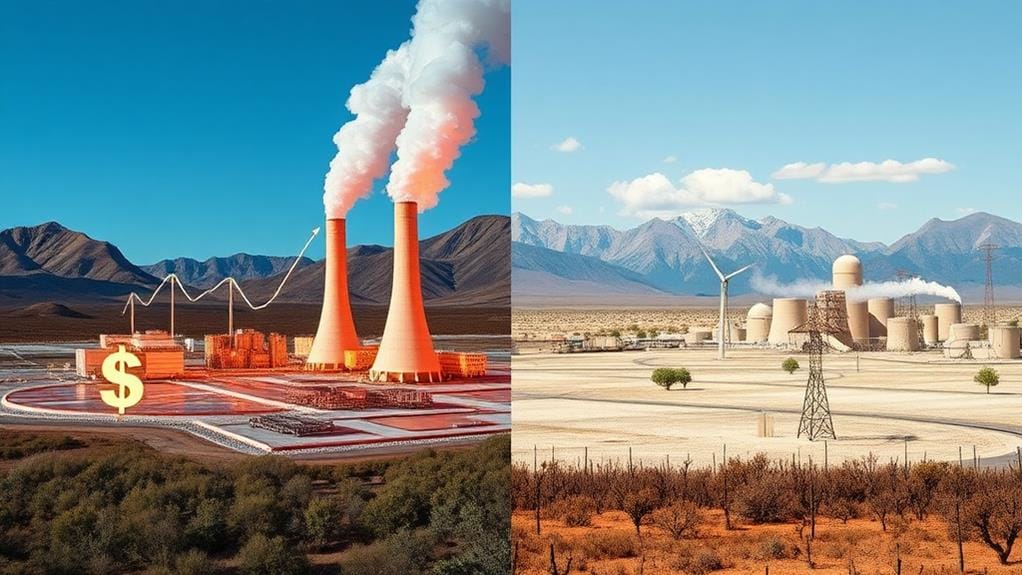
How do we weigh the economic implications of adopting geothermal energy? While the initial investment for geothermal projects can range from $2.5 to $7 million per megawatt, which may deter some, the long-term operational savings are compelling. These systems can reduce energy bills by up to 80%, showcasing their economic viability. Additionally, financial incentives, such as government subsidies, can cover up to 30% of installation costs, improving accessibility for both homeowners and businesses. The geothermal sector also promises significant job creation, from exploration to maintenance. Moreover, ongoing technological advancements are continually lowering costs and increasing efficiency, making geothermal energy a competitive player in the renewable energy market, ultimately enhancing its attractiveness for future investments.
Challenges and Disadvantages
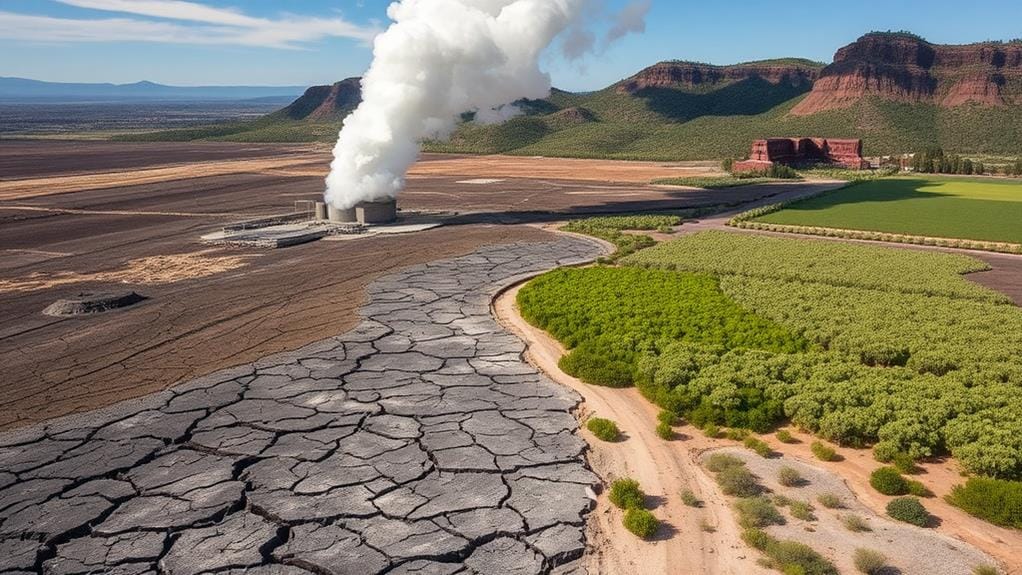
Often overlooked, the challenges and disadvantages of geothermal energy can raise concerns for potential investors and communities. While geothermal energy has its pros, we must acknowledge several key disadvantages:
- High Initial Costs: The initial investment for geothermal projects can range from $2.5 to $7 million per megawatt, which may deter potential investors.
- Environmental Risks: Extracting geothermal energy can release greenhouse gases like hydrogen sulfide and methane, posing risks despite lower overall emissions.
- Location-Specific Resources: Geothermal resources are primarily found in tectonic hotspots, limiting accessibility and creating regional disparities in energy availability.
The sustainability of geothermal energy relies on effective resource management practices, which are essential to prevent depletion and guarantee long-term viability. Ongoing research and technological advancements are critical in addressing these challenges.
Future of Geothermal Energy

As we look ahead, the future of geothermal energy is shaping up to be quite promising. Projections suggest that by 2050, geothermal energy could contribute 2-3% to global electricity generation, growing at a steady rate of approximately 2% annually. With technological advancements enhancing the efficiency of geothermal systems, we can expect reduced costs that will make these systems more economically viable. Additionally, increased exploration of new geothermal sites is likely to expand our geographical reach and tap into previously unutilized resources. Continuous research and development are essential for improving resource management and ensuring sustainability, particularly through enhanced geothermal systems (EGS). As recognition of geothermal energy’s role in the renewable energy mix grows, we anticipate increased policy support and investment, driving a shift towards sustainable energy solutions.
Technological Innovations
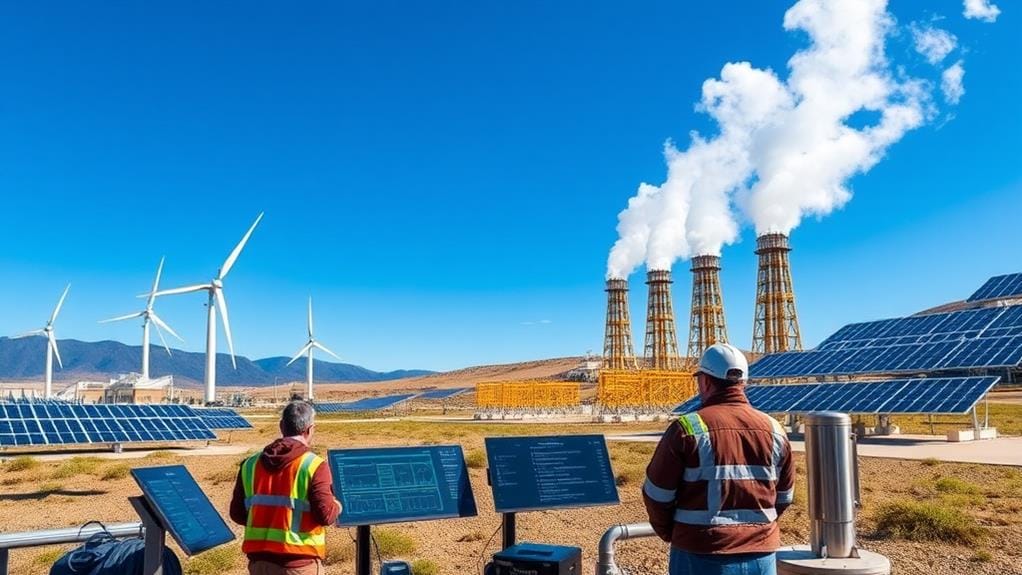
With the promising future of geothermal energy on the horizon, it’s exciting to see the technological innovations that are driving this growth. These advancements are setting the stage for a more sustainable energy landscape. Key innovations include:
- Enhanced Geothermal Systems (EGS): These allow us to tap into previously inaccessible geothermal resources, broadening our energy generation potential.
- Advanced Drilling Technology: Recent developments have reduced exploration and drilling costs by up to 25%, enhancing project viability.
- Improved Heat Exchangers and Binary Cycle Power Plants: These innovations increase efficiency in converting geothermal energy into electricity, optimizing even lower-temperature resources.
Furthermore, employing data analytics and sustainable fluid injection techniques helps manage resources effectively, ensuring the longevity and operational efficiency of geothermal projects.
Geothermal Energy Applications
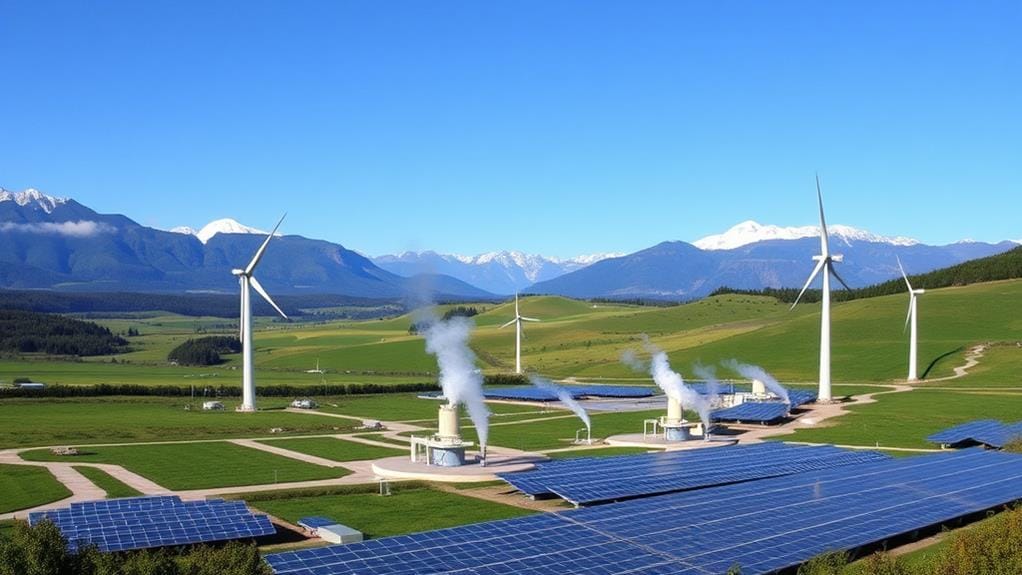
Geothermal energy offers a diverse range of applications that can greatly benefit our energy landscape. Regarding electricity generation, geothermal power plants are capable of producing up to 2,500 MW globally, utilizing technologies like flash steam and binary cycle systems. For residential needs, ground source heat pumps (GSHPs) provide efficient heating and cooling, resulting in energy savings of 25-50% compared to conventional systems. Furthermore, direct-use applications, such as district heating and greenhouse heating, demonstrate geothermal energy‘s versatility beyond electricity. Enhanced geothermal systems (EGS) further expand these applications by creating artificial reservoirs in areas lacking natural resources, potentially generating an additional 100 GW of electricity by 2050. Additionally, geothermal energy is employed in various industrial processes, including drying and food processing, leveraging its consistent heat supply.
Frequently Asked Questions
What Are 5 Advantages and Disadvantages of Geothermal Energy?
When exploring geothermal energy, we should consider its sustainability benefits, energy efficiency, and low environmental impact. However, we must also weigh economic viability, resource availability, and land use challenges alongside recent technological advancements.
What Are the Advantages of Geothermal Power?
When we explore geothermal power, we see its sustainability benefits and cost efficiency. It offers a reliable resource with minimal environmental impact, promoting energy independence through regional availability and bolstered by technological advancements. Together, we can thrive!
What Are the Advantages and Disadvantages of Geothermal Heat Pump?
When considering geothermal heat pumps, we should note their impressive geothermal efficiency and long system lifespan. However, installation costs can be high, and maintenance requirements vary, impacting energy savings and environmental impact in heating applications.
What Are Two Advantages of Geothermal Energy Quizlet?
Like a steady stream, geothermal energy offers us two key advantages: it’s a renewable resource with low emissions and remarkable energy efficiency. Plus, technological advancements help us achieve significant cost savings while minimizing land use.




